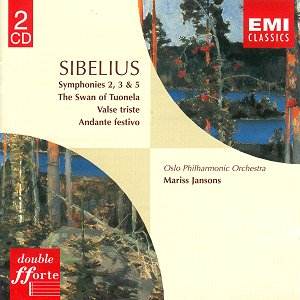In the 1980s Mariss Jansons made his presence felt
on the international stage with a still impressive cycle of the six
numbered symphonies by Tchaikovsky plus Manfred. The company
who took the gamble was Chandos. The orchestra was the Oslo Phil. So
far so good.
EMI began to cast covetous eyes towards this partnership
and were looking, quite naturally, to capitalise on Chandos's success.
The Sibelius symphonies were a natural successor to Tchaikovsky's -
all the better that Jansons had a grounding in Leningrad (now St Petersburg)
where both Evgeny Mravinsky and Arvid Jansons had produced some notably
accomplished and intense Sibelius. Combine this with the fact that here
was Jansons with a Nordic orchestra in Nordic music. The signs were
surely good. In any event EMI were looking for its equivalent of the
Maazel or Ashkenazy (Decca) or Davis (Philips) cycles of Sibelius symphonies.
It seems that neither Rattle's work with the CBSO nor Berglund's with
the Helsinki PO had quite hit the spot for EMI.
That is the way things turned out … or almost. The
sound quality across these two discs is stunning with the orchestra
presented with burnished colours and natural strength. For some reason
EMI never completed the cycle of seven. Only numbers 1, 2, 3 and 5 were
issued. I have never heard Jansons' No. 1 but it is reputed to be very
good. The Second Symphony is a strong contender and if you pick up this
set this version is no lame duck. The Third is the antithesis of the
Second - a cutting free and striking away from Tchaikovskian climactic
romance - a moving towards the cool classical yet humane ideals that
shine from the Sixth Symphony. While I have heard the ostinato played
more tightly this goes well enough. The second movement lacks tension.
The piece is superbly recorded - a comment that applies to both discs.
The heroic Fifth comes off even better. It is not ponderous, enjoys
a wide stereo spread and with wondrous depth and breadth in the sound-stage.
Jansons builds tension steadily. The ppp intensity registers
with profound pleasure (tr. 7 at 4.18). Decent versions of the shorter
Sibeliana. Why on earth do the shorter pieces have to cover the same
old territory? Why was Jansons not steered towards The Oceanides,
Nightride and Sunrise or Pohjola's Daughter?
A pleasing issue, then. Jansons is sympathetic
to the Sibelian ethic. A pity that the recorded cycle was never
completed. Was this simply that the tapes were never issued or were
the sessions simply cancelled or never booked?
Rob Barnett
